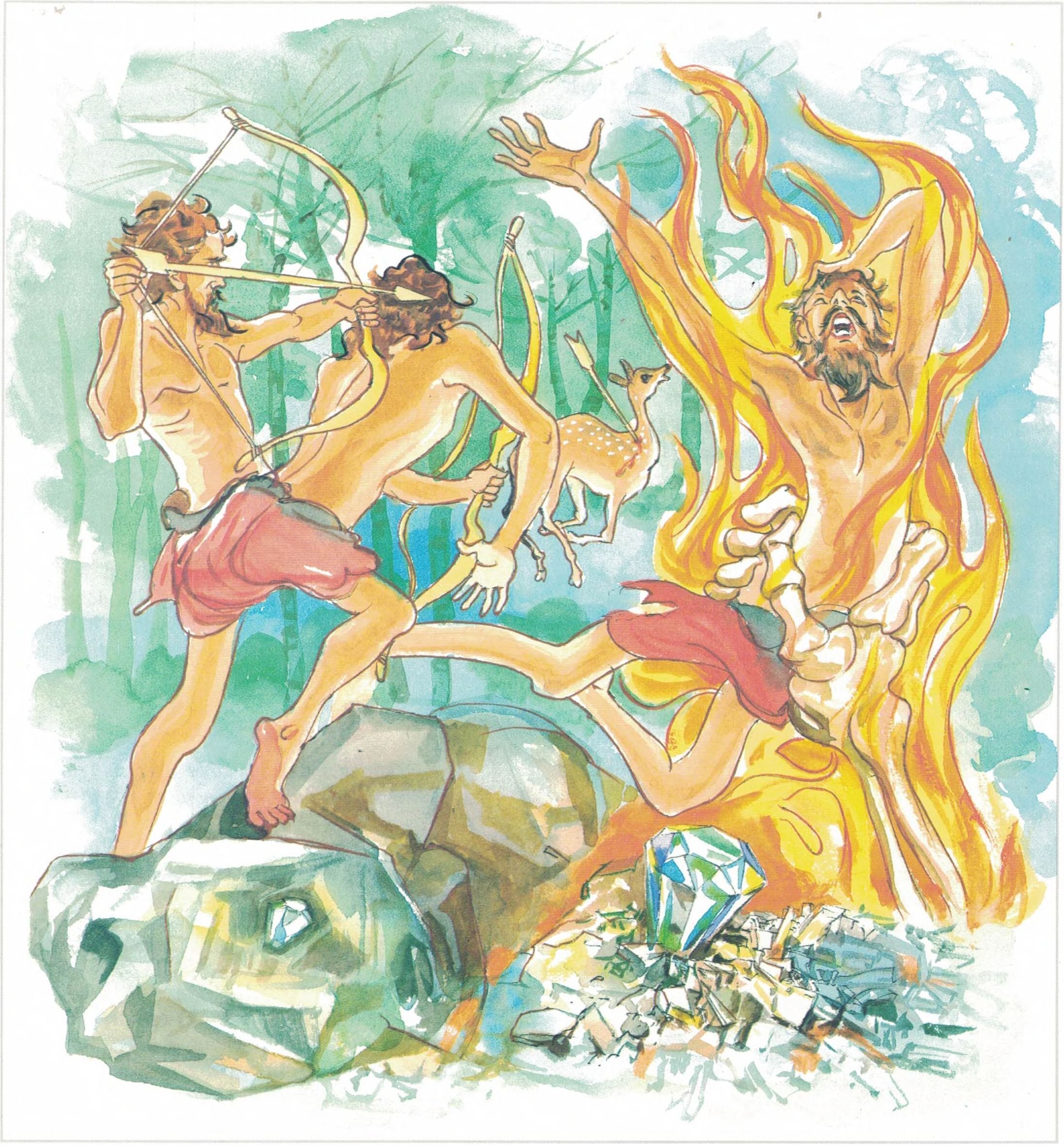Dhammapada (Illustrated)
by Ven. Weagoda Sarada Maha Thero | 1993 | 341,201 words | ISBN-10: 9810049382 | ISBN-13: 9789810049386
This page describes The Story of Mahakala Upasaka which is verse 161 of the English translation of the Dhammapada which forms a part of the Sutta Pitaka of the Buddhist canon of literature. Presenting the fundamental basics of the Buddhist way of life, the Dhammapada is a collection of 423 stanzas. This verse 161 is part of the Atta Vagga (Self) and the moral of the story is “A diamond being itself a stone, cuts stones. Likewise, self-wrought evil assails the fool”.
Verse 161 - The Story of Mahākāla Upāsaka
Pali text, illustration and English translation of Dhammapada verse 161:
attan'āva kataṃ pāpaṃ attajaṃ attasambhavaṃ |
abhimatthati dummedhaṃ vajiraṃ v'asmamayaṃ maṇiṃ || 161 ||
161. By oneself is evil done, it’s born of self and self-produced. Evil grinds the unwise one as diamond does the hardest gem.
 A diamond being itself a stone, cuts stones. Likewise, self-wrought evil assails the fool. |
The Story of Mahākāla Upāsaka
While residing at the Jetavana Monastery, the Buddha spoke this verse, with reference to Mahākāla, a lay disciple.
On a certain fast-day, Mahākāla, a lay disciple, went to the Jetavana Monastery. On that day, he kept the fast by observing the eight moral precepts (uposatha sīla) and listened to the discourses on the Dhamma throughout the night. It so happened that on that same night, some thieves broke into a house; and the owners on waking up went after the thieves. The thieves ran away in all directions. Some ran in the direction of the monastery. It was then nearing dawn, and Mahākāla was washing his face at the pond close to the monastery. The thieves dropped their stolen property in front of Mahākāla and ran on. When the owners arrived, they saw Mahākāla with the stolen property. Taking him for one of the thieves they shouted at him, threatened him and beat him hard. Mahākāla died on the spot. Early in the morning, when some young monks and sāmaneras from the monastery came to the pond to fetch water, they saw the dead body and recognized it.
On their return to the monastery, they reported what they had seen and said to the Buddha, “Venerable! The lay disciple who was at this monastery listening to the religious discourses all through the night has met with a death which he does not deserve.” To them the Buddha replied, “Monks! If you judge from the good deeds he has done in this existence, he has indeed met with death he does not deserve. But the fact is that he has only paid for the evil he had done in a past existence. In one of his previous existences, when he was a courtier in the palace of the king, he fell in love with another man’s wife and had beaten her husband to death. Thus, evil deeds surely get one into trouble; they even lead one to the four apāyas.”
Explanatory Translation (Verse 161)
attanā eva kataṃ attajaṃ attasambhavaṃ pāpaṃ asmamayaṃ
maṇiṃ vajiraṃ iva dummedhaṃ abhimanthati
attanā eva: by one’s own self; kataṃ [kata]: done; attajaṃ [attaja]: of one’s own self born; attasambhavaṃ [attasambhava]: sprung from one’s own self; pāpaṃ [pāpa]: evil action; asmamayaṃ [asmamaya]: produced by itself; maṇiṃ [maṇi]: precious stone; vajiraṃ iva: like the diamond; dummedhaṃ [dummedha]: the foolish person; abhimanthati: grinds
The diamond is born of, produced by and is sprung from stone. But it cuts the precious stone. The evil action is born of, produced by, and sprung from the evil doer.
Commentary and exegetical material (Verse 161)
vajiraṃ iva: like a diamond. In this stanza the image used for the selfdestroying evil of an unvirtuous person is the diamond which, though itself a stone, cuts all other gem stones.
The diamond, referred to in this stanza as vajira is defined, in traditional commentaries, this way:
vajateva na patihaññatte yassa gamanam kenaciti–vajiraṃ
(That which cuts all forms of objects is a diamond. It cannot be resisted.)
The following stanza emphasizes this idea:
Prithivyāṃ yāni ratnāni
ye cānye loha dhātavah
Sarvāni vilikhedvajram
tacca tair na vilikhyateThe diamond cuts all the metals and all the precious stones on earth.
Though it cuts all these, none of these can cut the diamond.
In the ancient lore on diamonds, it is said that wearing diamonds is conducive to good health and long-life. In this image the capacity of the diamond to cut other stones is compared to the effectiveness of one’s shortcomings in destroying one’s own self.
